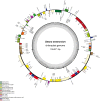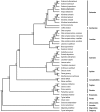Complete chloroplast genome sequence of poisonous and medicinal plant Datura stramonium: organizations and implications for genetic engineering
- PMID: 25365514
- PMCID: PMC4217734
- DOI: 10.1371/journal.pone.0110656
Complete chloroplast genome sequence of poisonous and medicinal plant Datura stramonium: organizations and implications for genetic engineering
Erratum in
- PLoS One. 2015;10(2):e0118236. Yuanye, Dang [corrected to Dang, Yuanye]; Qing, Li [corrected to Li, Qing]; Jinjian, Lu [corrected to Lu, Jinjian]; Xiwen, Li [corrected to Li, Xiwen]; Yitao, Wang [corrected to Wang, Yitao]
Abstract
Datura stramonium is a widely used poisonous plant with great medicinal and economic value. Its chloroplast (cp) genome is 155,871 bp in length with a typical quadripartite structure of the large (LSC, 86,302 bp) and small (SSC, 18,367 bp) single-copy regions, separated by a pair of inverted repeats (IRs, 25,601 bp). The genome contains 113 unique genes, including 80 protein-coding genes, 29 tRNAs and four rRNAs. A total of 11 forward, 9 palindromic and 13 tandem repeats were detected in the D. stramonium cp genome. Most simple sequence repeats (SSR) are AT-rich and are less abundant in coding regions than in non-coding regions. Both SSRs and GC content were unevenly distributed in the entire cp genome. All preferred synonymous codons were found to use A/T ending codons. The difference in GC contents of entire genomes and of the three-codon positions suggests that the D. stramonium cp genome might possess different genomic organization, in part due to different mutational pressures. The five most divergent coding regions and four non-coding regions (trnH-psbA, rps4-trnS, ndhD-ccsA, and ndhI-ndhG) were identified using whole plastome alignment, which can be used to develop molecular markers for phylogenetics and barcoding studies within the Solanaceae. Phylogenetic analysis based on 68 protein-coding genes supported Datura as a sister to Solanum. This study provides valuable information for phylogenetic and cp genetic engineering studies of this poisonous and medicinal plant.
Conflict of interest statement
Figures






Similar articles
-
The complete chloroplast genome sequence of the medicinal plant Salvia miltiorrhiza.PLoS One. 2013;8(2):e57607. doi: 10.1371/journal.pone.0057607. Epub 2013 Feb 27. PLoS One. 2013. PMID: 23460883 Free PMC article.
-
Complete chloroplast genome sequence of a major economic species, Ziziphus jujuba (Rhamnaceae).Curr Genet. 2017 Feb;63(1):117-129. doi: 10.1007/s00294-016-0612-4. Epub 2016 May 20. Curr Genet. 2017. PMID: 27206980
-
The Complete Chloroplast Genome Sequences of the Medicinal Plant Forsythia suspensa (Oleaceae).Int J Mol Sci. 2017 Oct 31;18(11):2288. doi: 10.3390/ijms18112288. Int J Mol Sci. 2017. PMID: 29088105 Free PMC article.
-
Complete Chloroplast Genome of Medicinal Plant Lonicera japonica: Genome Rearrangement, Intron Gain and Loss, and Implications for Phylogenetic Studies.Molecules. 2017 Feb 7;22(2):249. doi: 10.3390/molecules22020249. Molecules. 2017. PMID: 28178222 Free PMC article.
-
A long road ahead to reliable and complete medicinal plant genomes.Nat Commun. 2025 Mar 4;16(1):2150. doi: 10.1038/s41467-025-57448-8. Nat Commun. 2025. PMID: 40032878 Free PMC article. Review.
Cited by
-
Comparing chloroplast genomes of traditional Chinese herbs Schisandra sphenanthera and S. chinensis.Chin Herb Med. 2020 Jun 22;12(3):247-256. doi: 10.1016/j.chmed.2019.09.009. eCollection 2020 Jul. Chin Herb Med. 2020. PMID: 36119003 Free PMC article.
-
Chloroplast Genome Sequence of Pigeonpea (Cajanus cajan (L.) Millspaugh) and Cajanus scarabaeoides (L.) Thouars: Genome Organization and Comparison with Other Legumes.Front Plant Sci. 2016 Dec 9;7:1847. doi: 10.3389/fpls.2016.01847. eCollection 2016. Front Plant Sci. 2016. PMID: 28018385 Free PMC article.
-
Comparative analysis of the complete chloroplast genomes of six threatened subgenus Gynopodium (Magnolia) species.BMC Genomics. 2022 Oct 20;23(1):716. doi: 10.1186/s12864-022-08934-6. BMC Genomics. 2022. PMID: 36261795 Free PMC article.
-
Complete Chloroplast Genomes from Sanguisorba: Identity and Variation Among Four Species.Molecules. 2018 Aug 24;23(9):2137. doi: 10.3390/molecules23092137. Molecules. 2018. PMID: 30149578 Free PMC article.
-
Comparative chloroplast genome analyses of cultivated spinach and two wild progenitors shed light on the phylogenetic relationships and variation.Sci Rep. 2022 Jan 17;12(1):856. doi: 10.1038/s41598-022-04918-4. Sci Rep. 2022. PMID: 35039603 Free PMC article.
References
-
- Weissman B, Raveh L (2011) Multifunctional drugs as novel antidotes for organophosphates' poisoning. Toxicology 290: 149–155. - PubMed
-
- Jakabova S, Vincze L, Farkas A, Kilar F, Boros B, et al. (2012) Determination of tropane alkaloids atropine and scopolamine by liquid chromatography-mass spectrometry in plant organs of Datura species. Journal of Chromatography A 1232: 295–301. - PubMed
-
- Lacy BE, Wang F, Bhowal S, Schaefer E (2013) On-demand hyoscine butylbromide for the treatment of self-reported functional cramping abdominal pain. Scandinavian Journal of Gastroenterology 48: 926–935. - PubMed
-
- Klinkenberg I, Blokland A (2010) The validity of scopolamine as a pharmacological model for cognitive impairment: A review of animal behavioral studies. Neuroscience and Biobehavioral Reviews 34: 1307–1350. - PubMed
Publication types
MeSH terms
Substances
LinkOut - more resources
Full Text Sources
Other Literature Sources
Miscellaneous

